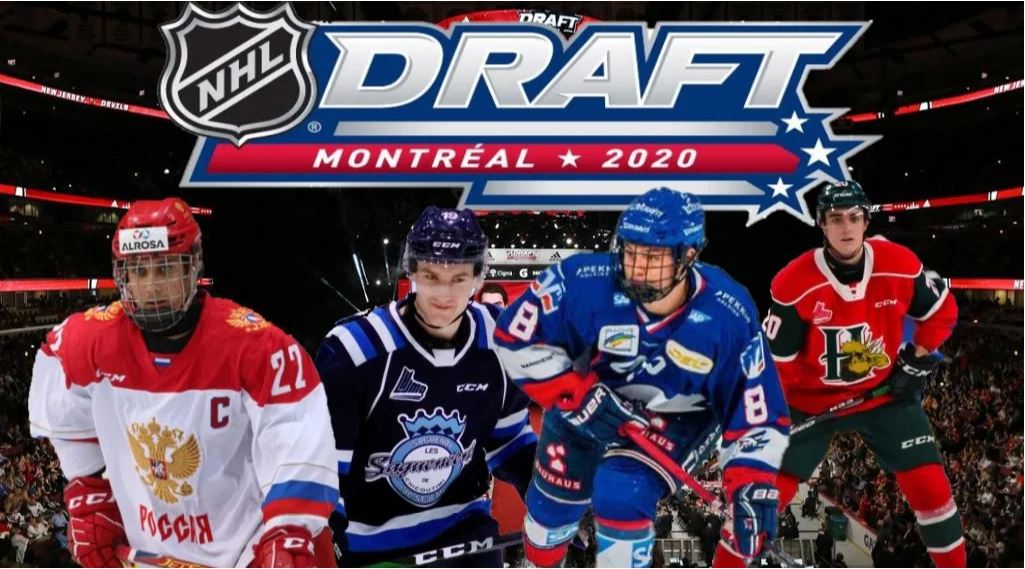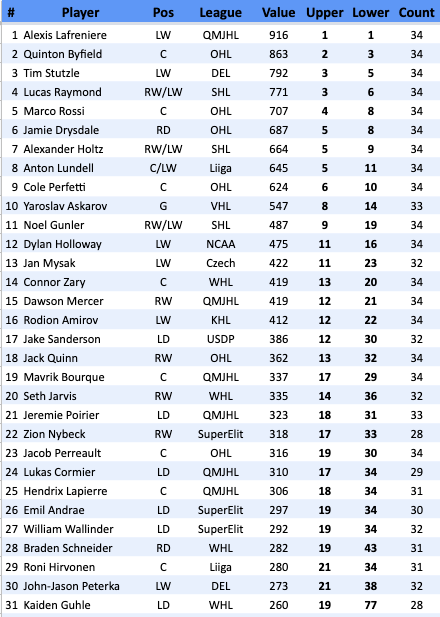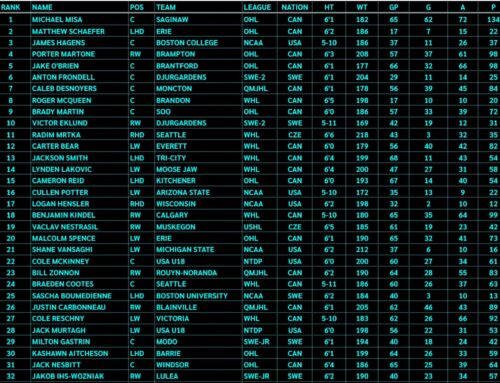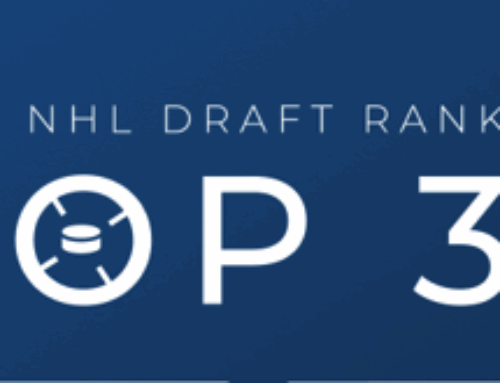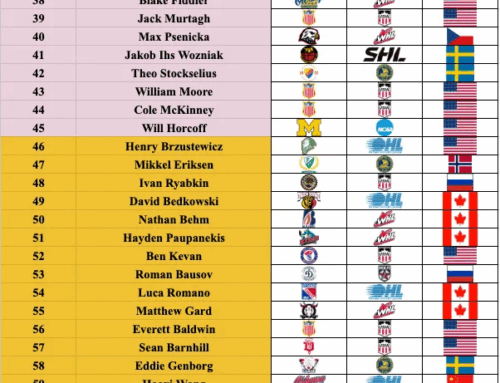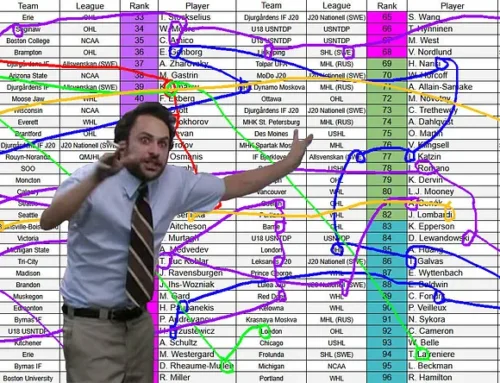Analysis: Draft Groupthink
Mason Black
2020-05-01
Groupthink is a phenomenon where a group of individuals make irrational choices in the decision-making process, because they conform to overall group results. Spend enough time on Twitter and it will not take you long to spot this mentality, both inside and outside of the hockey world, if you are looking for it.
With the postponement of all hockey leagues around the world you may have noticed an exponential increase in the influx of mock drafts and draft rankings that start to look the same over time. For me, at least, these rankings have helped to keep my sanity, but it is quite interesting to see the same players quickly climbing/falling different draft boards despite the fact that no game has been played in well over a month. This can create a mindset that amateur draft prognosticators are correct in their analysis because so many different people are in agreement with one another, which I would attribute to unintentional Groupthink.
Even if you are not an NFL fan, you more than likely have recently come across some sort of ranking that evaluates how each team did at the recent NFL draft. Heck, I saw multiple organizational draft rankings after each individual round, and I follow explicitly hockey-related content on social media (Twitter). This is where things can become dangerous if you begin to join the Groupthink phenomenon, which can be detrimental to your fantasy team.
On one side, you have journalists and bloggers who have watched many games and countless hours of YouTube videos on many of the top prospects to come up with their evaluation. I do not want to take anything away from the commitment and importance of the vast majority of these opinions because I appreciate the amount of time that comes with this type of analysis. Plus, most of the time they offer this evaluation free of charge. On the other hand, multi-billion-dollar businesses invest massive amounts of capital and resources into identifying the long-term potential of its choices at the draft table, which are understandably hidden from public examination. I would pay heavily for a reality show to give behind the scenes coverage of the development of an NHL team’s draft list.
Only time will tell how each draft pick develops within an organization, but I for one lean towards using the knowledge of the top minds in the field that are working directly within those professional organizations. The only problem with that philosophy is that you have to wait until the results of the draft before making your decisions, and you may not have the luxury to do so depending on the dates of your league’s draft. Even then, it is impossible to know the reasons behind why such important decisions were made. Almost assuredly there are some phenomenal scouts that are not currently associated with an NHL team, but the vast majority of the best minds that want to work in the demanding job of scouting are already employed by professional teams.
It can, at times, become humorous when “Joe Schmo Blogger” becomes highly critical of a specific draft selection because it does not coincide with what their pick would have been. Last year Detroit was uniformly lambasted for using their sixth overall pick to select Moritz Seider. However, can anyone honestly look back at that pick as a bad selection? You may want to hold off on taking him in a points-only fantasy league, but in multi-category leagues he could provide a serious bang-for-your-buck, and is arguably developing at a faster rate than any other prospect from the 2019 draft. Such is the case with Seider, you must also be careful to realize that NHL teams have a different mandate that probably does not align with the categories of your dynasty league.
The COVID-19 pandemic has seriously put the conventional wisdom and scouting tradition at risk and NHL scouts have no other option but to resort to watching game-tape in order to build their final evaluation. Furthermore, the most important games to evaluate how a prospect rises to the occasion against stiffer competition in more meaningful playoff games, have been wiped from the slate. That may lead to more big misses and hits at the draft table compared to recent drafts. To add another twist to the ever-evolving story, the NHL is seriously considering holding the NHL draft in June, with the possibility to complete the 2019-2020 season afterwards.
Fortunately, the fine folks at DobberProspects have collectively watched an endless number of games and prospect footage to help steer you away from that Groupthink mentality. Look no further than our own editor-in-chief’s bold prediction that Quinton Byfield should be the first overall pick in the upcoming 2020 draft; whenever that will take place. Cam Robinson makes a compelling argument as to the top end potential of Byfield and the overall impact he could make as a franchise player in the NHL.
Similar to actual NHL teams, DobberProspects provides regional scouting and team specific evaluation. Something that is not done anywhere else, and they provide this feature entirely free. It is impossible for one single person to have a grasp on all draft eligible prospects because they ultimately spread themselves too thin and are only able to get a handful of viewings at most. On top of that, if you ask any scout they will all agree at the importance of scrutinizing players in person as opposed to television viewings. You have probably noticed the difference yourself while attending a live game.
Here are a handful of the amazing crew that is currently working towards bringing you the best draft and prospect coverage found anywhere:
Cam Robinson (@HockeyRobinson) – The managing editor at DP, has a unique way of articulating a breakdown of a player’s strengths and weaknesses and does so both clearly and concisely. I can only imagine that this relates back to his background as a teacher.
Jokke Nevalainen (@JokkeNevalainen) – The head of European Scouting is an unlimited fountain of information when it comes to one of the least focused areas in public prospect analysis due to his tireless work ethic. He has amassed a small army of regional European scouts.
Peter Harling (@pharling) – If you live in Ontario and spend any amount of time at the rink, you more than likely have crossed paths with Peter. He graciously offers his input on prospects on DobberProspects Radio (@DPR_show). If you are in to podcasts, his segments are ‘must-listen’ audio.
Pat Quinn (@FHPQuinn) – Associate Editor at DP, Quinn is a staple on the “Ramblings” and provides a unique look at many of the players that will eventually land on your fantasy team.
Tony Ferrari (@theTonyFerrari) – Jr. Associate Editor at DP, Tony seemingly has his hands in everything. He is a fantastic follow on Twitter and continues to pump out high quality content on a variety of different platforms.
Hayden Soboleski (@soboleskih) – Although he has stepped back in terms of his duties at DP, Hayden provides in-depth analysis with a slant towards the analytics side of prospect investigation. A great follow on Twitter and is always a step ahead when it comes to Avalanche prospects.
Lucas Main (@Lam1926)– Another scout that provides OHL content, Lucas has a depth of knowledge when it comes to fantasy and is easily one of the most difficult fantasy opponents I have ever come across.
Joel Henderson (@dathockeyjoe) – You will not find better WHL analysis than what Joel provides on a daily basis.
Sam Stern (@SternScouting) – DP’s resident NCAA expert. Sam provides a lot more than only U.S. amateur hockey scouting.
Dylan Griffing (@Dylan_Griffing) – A great follow on Twitter with some excellent graphics and advanced stats to go along with his evaluations. He is quickly ascending as a go-to name in the prospect world.
Nicklas Kawka (@KawkaPuck) – Fantastic analysis out of the QMJHL Nicholas is quickly rising up the ranks as a go-to scout.
Brayden Olafson (@olaf1393) – Another fantastic QMJHL scout, Brayden is very knowledgeable about the next set of prospects from the ‘Q’ that will wind up on your fantasy team.
Mark Hillier (@AngryPuck) – If it has to do with the Red Wings, you know Mark is going to be all over it. I’ve seen him come in multiple dynasty leagues and rocket up the standings as he clearly knows his stuff when it comes to roster development.
Will Scouch (@Scouching) – Will is quickly building his prospect empire and does intense prospect video analysis, while incorporating both the eye-test and advanced stats.
I apologize because unfortunately I probably missed a few writers that deserve more recognition, but this gives a snapshot of the wealth of information provided here at DobberProspects.
*****************************
How can you benefit from draft Groupthink?
First and foremost, I would highly recommend reading the profiles of each prospect that is provided here at DobberProspects. The wide array of analysis will give you an in-depth look into the potential of each player; especially when multiple writers are giving different perspectives on the same player. It is easily the greatest single resource to gain a better understanding of player strengths and weaknesses that is explicitly created with a slant towards fantasy hockey.
Next, I would like to lay out for you a few different draft rankings in an exercise to try to identify how to use draft Groupthink to your advantage when it is time for you to make your own draft selections.
First, I would like to share with you some great work put together by Colin Cudmore (@CudmoreColin) where he has consolidated a list of the top prospects for the 2020 draft based from public rankings. Over 30 different lists have been compiled to build a clear order in which the prospects are expected to be taken in the upcoming draft. Every prognosticator has bias, but that is essentially eliminated when the law of averages takes over in a decent sample size. One man’s sleeper quickly disappears when it gets integrated into the consensus.
The first tip is to refer back to this list as the actual NHL draft approaches, or when your fantasy league holds theirs. Compare which players’ stock have fallen and risen over the course of that time-frame as Colin updates the rankings. For instance, when he first publicly posted the list Anton Lundell was ranked as the fourth overall consensus pick, but has now dropped down to eighth overall, and many new rankings have him as a bubble top-10 pick because of substantiated worries surrounding his skating. On the other end, Tim Stuetzle was once ranked as the consolidated 10th overall selection and has now rocketed his way up to third position.
Last year, Cudmore matched the consolidated rankings against the way players were actually selected during the 2019 NHL draft, and assigned one of two criteria – steal, reach – based on how far away a player was compared to his expected range. Here are the players considered a ‘reach’ that were drafted inside the first round: Kirby Dach (7), Victor Soderstrom (14), Philip Broberg (15), Moritz Seider (17), Spencer Knight (25), Samuel Poulin (30), Tobias Bjornfot (31), Lassi Thomson (37), Simon Holmstrom (23), John Beecher (43) and Brayden Tracey (45). The number indicates where they were ranked prior to the draft. Although the verdict is still out on most of the players, after another year of development I do not know if I would really consider any of them to be major reaches at this point in time.
There were only three players that were registered as steals that were taken inside the first round: Cole Caufield (8), Peyton Krebs (9), and Ryan Suzuki (22). The consolidated rankings had many players expected to be selected inside the first round, but were classed as ‘steals’ afterwards when they fell at the actual draft: Artur Kaliyev (13), Bobby Brink (21), Raphael Lavoie (23), Pavel Dorofeyev (24), Nils Hoglander (27) and Nicholas Robertson (28). I would suggest that most of these players have outplayed their real-life draft position and now fall a lot closer to their expected pre-draft ranking.
Next, I would like to take a look at the top ranked players inside the NHL Rank King app. This is also constantly evolving, but instead of month-by-month variations it can often times change minute-by-minute. Every time a vote is cast inside the “Who’d You Rather?” portion of the app that asks a user to select the better option between two draft eligible prospects a cumulative score is modified to create an overall ranking. When a Bob McKenzie or Craig Button publicly posts their lists on their respective corporation’s website, you can almost instantly see the groupthink state of mind get incorporated inside these rankings.
Much like any of the rankings incorporated inside the app, they can give a better sense of how the populace is viewing a specific player at any given time. With literally hundreds of thousands of votes cast, individual players ride the waves and troughs of popular opinion. This can give you a leg up on your opponents by knowing the range to expect a player to be taken and compare that against their true NHL draft value.
The last thing I would like to show you is a poll I have been running each day on Twitter that gives four draft-eligible player options to be selected as the next pick in a draft. Except for a couple of swaps, the first ten picks are almost identical to those posted in Cudmore’s consolidated list. The next ten are where things get a bit more interesting, but certainly follows the mainstream trends of players. Unfortunately, I am only through the first half of picks so far, but you will get a good idea of the draft tendencies. You can follow me on Twitter (@NHLRankKing) to add your input when the next polls come up.
Previous draft results:
1 Lafreniere
2 Byfield
3 Stutzle
4 Rossi
5 Raymond
6 Drysdale
7 Perfetti
8 Holtz
9 Lundell
10 Askarov
11 Gunler
12 Jarvis
13 Sanderson
14 Quinn
15 Mysak
16 Zary— Mason Black (@NHLRankKing) April 29, 2020
1 Alexis Lafreniere
2 Quinton Byfield
3 Tim Stutzle
4 Marco Rossi
5 Lucas Raymond
6 Jamie Drysdale
7 Cole Perfetti
8 Alexander Holtz
9 Anton Lundell
10 Yaroslav Askarov
11 Noel Gunler
12 Seth Jarvis
13 Jake Sanderson
14 Jack Quinn
15 Jan Mysak
16 Connor Zary
17 Dylan Holloway
To summarize, be careful of putting too much stock into pre-draft rankings and use the actual 2020 NHL Draft as your first resource when building your fantasy draft rankings. Doing your research and reading up on players can pay huge dividends when selecting players based on your fantasy league categories.
Good luck drafting!
Mason Black (@NHLRankKing)


